Effect of Injecting Epoxy Resin Adhesive into Cement Mortar on Tile Adhesion Performance
Abstract
1. Introduction
2. Materials and Methods
2.1. Materials and Mixture Proportions
2.2. Experimental Plan and Test Methodology
- Air curing: standard condition for 28 d (23 ± 2 °C, 50 ± 5% RH).
- Water curing: standard condition for 7 d and water curing for 21 d (20 ± 2 °C).
- Freeze–thawing: standard condition for 7 d, water curing for 21 d and 25 cycles of freeze–thawing (−15 ± 3 °C, 15 ± 3 °C for 2 h ± 20 min, respectively).
- Salt immersion: standard condition for 28 d, immersion in chlorinated water (chlorine content: 0.3~0.6 mg/L, pH value: 6.5~7.8) for 7 d, rinse with clean tap water, standard condition for 24 h.
3. Results and Discussion
3.1. Permeability of Epoxy Resin into Mortar
3.2. Mechanical Properties
3.3. Shrinkage Characteristics
3.4. Adhesive Strength of Tile with Epoxy Resin Injection Reinforcement
4. Conclusions
- (1)
- As a result, in the case of using an epoxy resin adhesive within the scope of this study, the adhesive strength improved up to about two times compared to that of using the existing dry cement mortar under the air curing condition. However, it was confirmed that the adhesion strength decreased by up to about 30% compared to using dry cement mortar under water curing and freeze-thaw conditions. Meanwhile, in salt immersion and laitance conditions, it showed about four and two times higher adhesion strength than dry cement mortar, respectively.
- (2)
- The workability and permeability of the epoxy resin adhesive were enhanced at a solvent mixing ratio of 0.5 wt%. It is believed that this epoxy adhesive not only penetrated the interfaces of the tiles, mortar, and concrete, but also the mortar itself, thus improving the mechanical adhesion between each interface. This characteristic is potentially effective in improving the adhesion performance of porcelain and polished tiles with small pores, which make it difficult for the mortar to penetrate and mechanically adhere to the tiles.
- (3)
- In addition to the improved mechanical adhesion between the tiles and mortar, the epoxy resin reinforcement also minimized the deterioration of adhesion due to shear stress by reducing the moisture evaporation and drying shrinkage of the mortar, which consequently reduced the shrinkage of the tiles themselves. In particular, the epoxy resin was expected to improve the adhesion performance of the large-sized tiles that are currently in demand because these tiles experience greater shear stress from shrinkage.
- (4)
- The vulnerability of epoxy to moisture was observed under water and freeze-thaw curing conditions. However, based on the evaluation of the adhesion performance after standard air curing and salt immersion, the adhesion performance should be maintained if a stable level of performance is achieved by adequate air curing prior to exposure to harsh environments. However, further investigation of the effect of long-term exposure to harsh environments on the durability is required.
Author Contributions
Funding
Conflicts of Interest
References
- Carasek, H.; Cascudo, O.; Scartezini, L.M. Importância Do Materiais Na Aderência Os Revestimentos de Argamassa. In IV Simpoósio Brasileiro de Tecnoloia das Argamassas; Associação Nacional de Tecnologia do Ambiente Construído: Porto Alegre, Brazil, 2001; pp. 43–67. [Google Scholar]
- Almeida, A.E.F.d.S.; Sichieri, E.P. Experimental Study on Polymer-Modified Mortars with Silica Fume Applied to Fix Porcelain Tile. Build. Environ. 2007, 42, 2645–2650. [Google Scholar] [CrossRef]
- Sánchez, E.; Ibáñez, M.J.; García-Ten, J.; Quereda, M.F.; Hutchings, I.M.; Xu, Y.M. Porcelain Tile Microstructure: Implications for Polished Tile Properties. J. Eur. Ceram. Soc. 2006, 26, 2533–2540. [Google Scholar] [CrossRef]
- Carty, W.M.; Senapati, U. Porcelain-Raw Materials, Processing, Phase Evolution, and Mechanical Behavior. J. Am. Ceram. Soc. 1998, 81, 3–20. [Google Scholar] [CrossRef]
- Mansur, A.A.P.; Santos, D.B.; Mansur, H.S. A Microstructural Approach to Adherence Mechanism of Poly (Vinyl Alcohol) Modified Cement Systems to Ceramic Tiles. Cem. Concr. Res. 2007, 37, 270–282. [Google Scholar] [CrossRef]
- Inspect of the Government Offices Data; The National Assembly of the Republic of Korea Land Infrastructure & Transport Committee: Seoul, Korea, 2018.
- Mansur, A.A.P.; Nascimento, O.A.; Mansur, H.S. Data Collection of Five Years of Exterior Facade Pathologies in Brazil. In Proceedings of the QUALICER 2006: IX World Congress on Ceramic Tile Quality, Castellón, Spain, 12–15 February 2006; Volume 2, pp. 107–120. [Google Scholar]
- Silvestre, J.D.; de Brito, J. Ceramic Tiling Inspection System. Constr. Build. Mater. 2009, 23, 653–668. [Google Scholar] [CrossRef]
- Wetzel, A.; Zurbriggen, R.; Herwegh, M. Spatially Resolved Evolution of Adhesion Properties of Large Porcelain Tiles. Cem. Concr. Compos. 2010, 32, 327–388. [Google Scholar] [CrossRef]
- Wetzel, A.; Herwegh, M.; Zurbriggen, R.; Winnefeld, F. Influence of Shrinkage and Water Transport Mechanisms on Microstructure and Crack Formation of Tile Adhesive Mortars. Cem. Concr. Res. 2012, 42, 39–50. [Google Scholar] [CrossRef]
- Ohama, Y.; Demura, K.; Endo, T. Properties of Polymer-Modified Mortars Using Epoxy Resin Without Hardener. ASTM Int. 1993, 1176, 90–103. [Google Scholar]
- Ohama, Y.; Demura, K.; Katsuhata, T. Investigation of Microcracks Self-Repair Function of Polymer-Modified Mortars Using Epoxy Resins without Hardener. In Proceedings of the 10th International Congress on Polymers in Concrete (CD-ROM); Fowler, D.W., DePuy, G.W., Murray, M.A., Eds.; The University of Texas at Austin: Austin, TX, USA, 2001. [Google Scholar]
- Jenni, A.; Holzer, L.; Zurbriggen, R.; Herwegh, M. Influence of polymers on microstructure and adhesive strength of cementitious tile adhesive mortars. Cem. Concr. Res. 2005, 35, 35–50. [Google Scholar] [CrossRef]
- Zheng, Z.; Li, Y.; Ma, X.; Zhu, X.; Li, S. High density and high strength cement-based mortar by modification with epoxy resin emulsion. Constr. Build. Mater. 2019, 197, 319–330. [Google Scholar] [CrossRef]
- Herold, H. Fixing of stoneware “porcelanic” tiles by means of ceramic tile adhesives modified with redispersible polymer powder. In Proceedings of the World Congress on Ceramic Tile Quality, Castellón, Spain, 3–6 March 2000; pp. 77–88. [Google Scholar]
- Jenni, A.; Herwegh, M.; Zurbriggen, R.; Aberle, T.; Holzer, L. Quantitative Microstructure Analysis of Polymer-Modified Mortars. J. Microsc. 2003, 212, 186–196. [Google Scholar] [CrossRef] [PubMed]
- Yeon, J. Deformability of Bisphenol A-Type Epoxy Resin-Based Polymer Concrete with Different Hardeners and Fillers. J. Appl. Sci. 2020, 10, 1336. [Google Scholar] [CrossRef]
- Bijen, J.; Schlangen, E.; Salet, T. Modelling of Effects of Shrinkage on the Performance of Adhesives. In Second International RILEM Symposium on Adhesion between Polymers and Concrete; RILEM Publications SARL: Dresden, Germany, 1999; pp. 299–310. [Google Scholar]
- Rottstegge, J.; Arnold, M.; Herschke, L.; Glasser, G.; Wilhelm, M.; Spiess, H.W.; Hergeth, W.D. Solid state NMR and LVSEM studies on the hardening of latex modified tile mortar systems. Cem. Concr. Res. 2005, 35, 2233–2243. [Google Scholar] [CrossRef]
- Gretz, M.; Plank, J. An ESEM investigation of latex film formation in cement pore solution. Cem. Concr. Res. 2011, 41, 184–190. [Google Scholar] [CrossRef]
- Sugiman, S.; Salman, S.; Maryudi, M. Effects of Volume Fraction on Water Uptake and Tensile Properties of Epoxy Filled with Inorganic Fillers Having Different Reactivity to Water. Mater. Today Commun. 2020, 101360. [Google Scholar] [CrossRef]
- Li, X.; Chen, M.; Zhang, J.; Gao, Q.; Zhang, S.; Li, J. Physico-Chemical Properties of Soybean Meal-Based Adhesives Reinforced by Ethylene Glycol Diglycidyl Ether and Modified Nanocrystalline Cellulose. Polymers 2017, 9, 463. [Google Scholar] [CrossRef] [PubMed]
- Sugiman, S.; Putra, I.K.P.; Setyawan, P.D. Effects of the Media and Ageing Condition on the Tensile Properties and Fracture Toughness of Epoxy Resin. Polym. Degrad. Stab. 2016, 134, 311–321. [Google Scholar] [CrossRef]





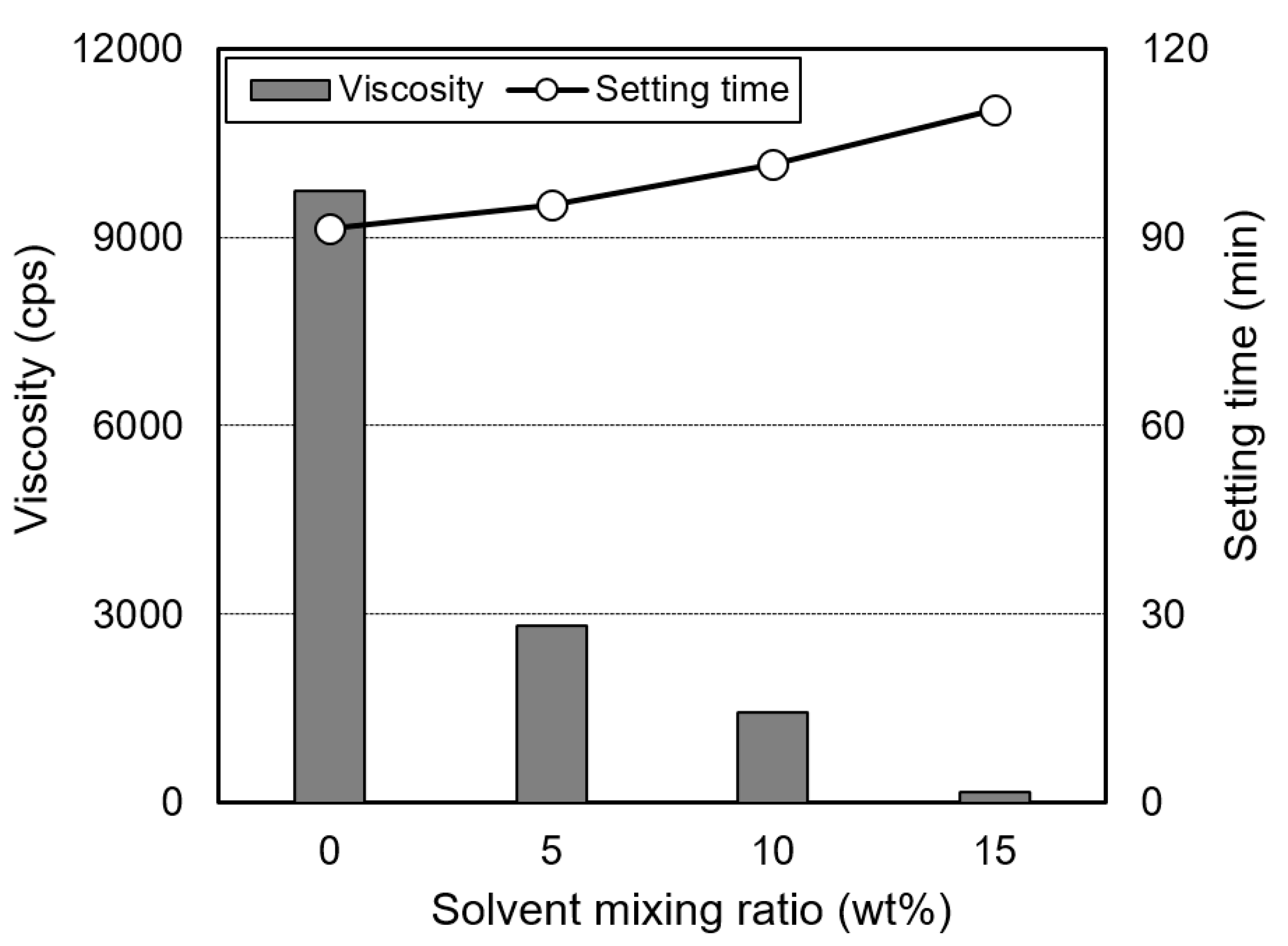
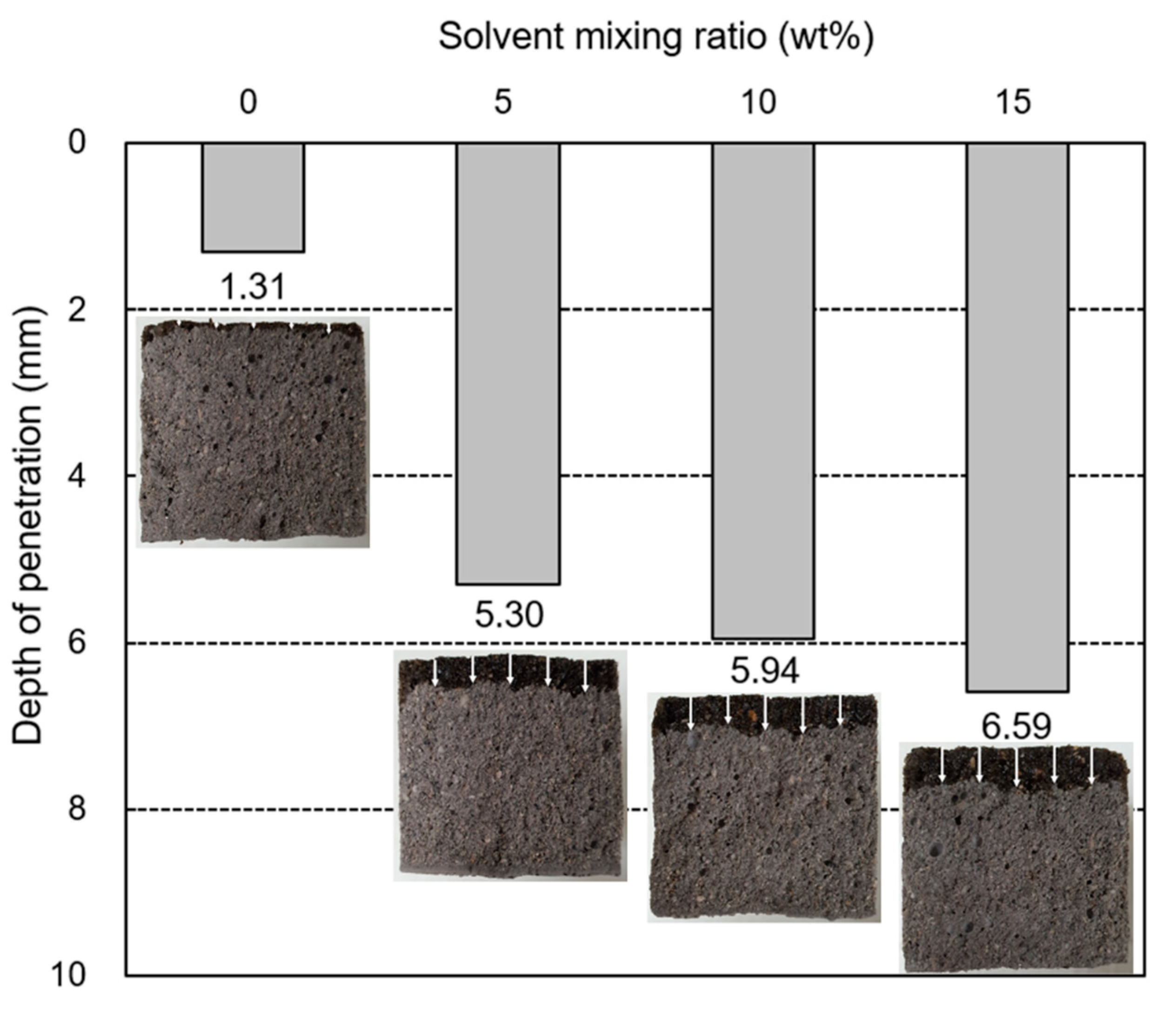
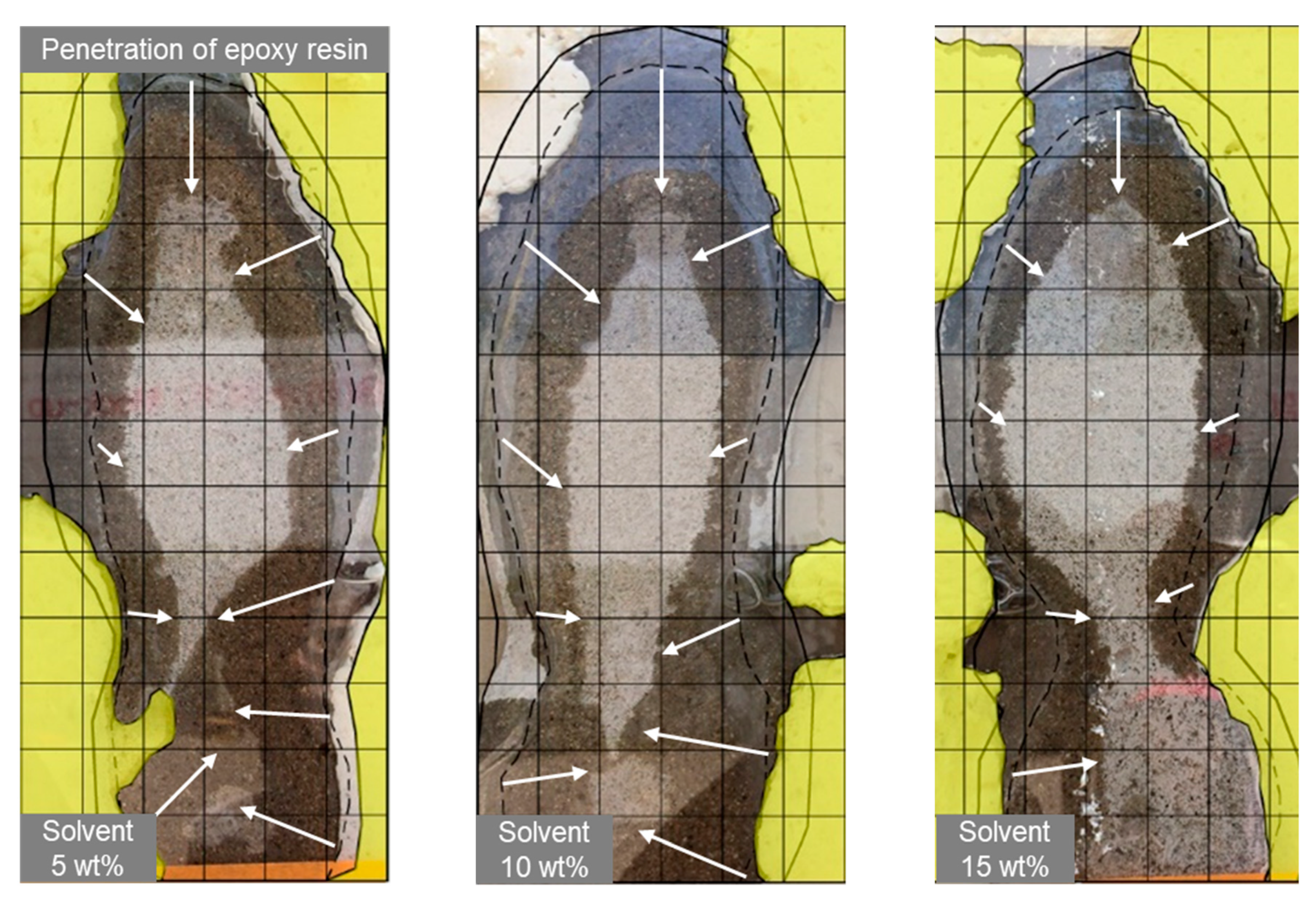
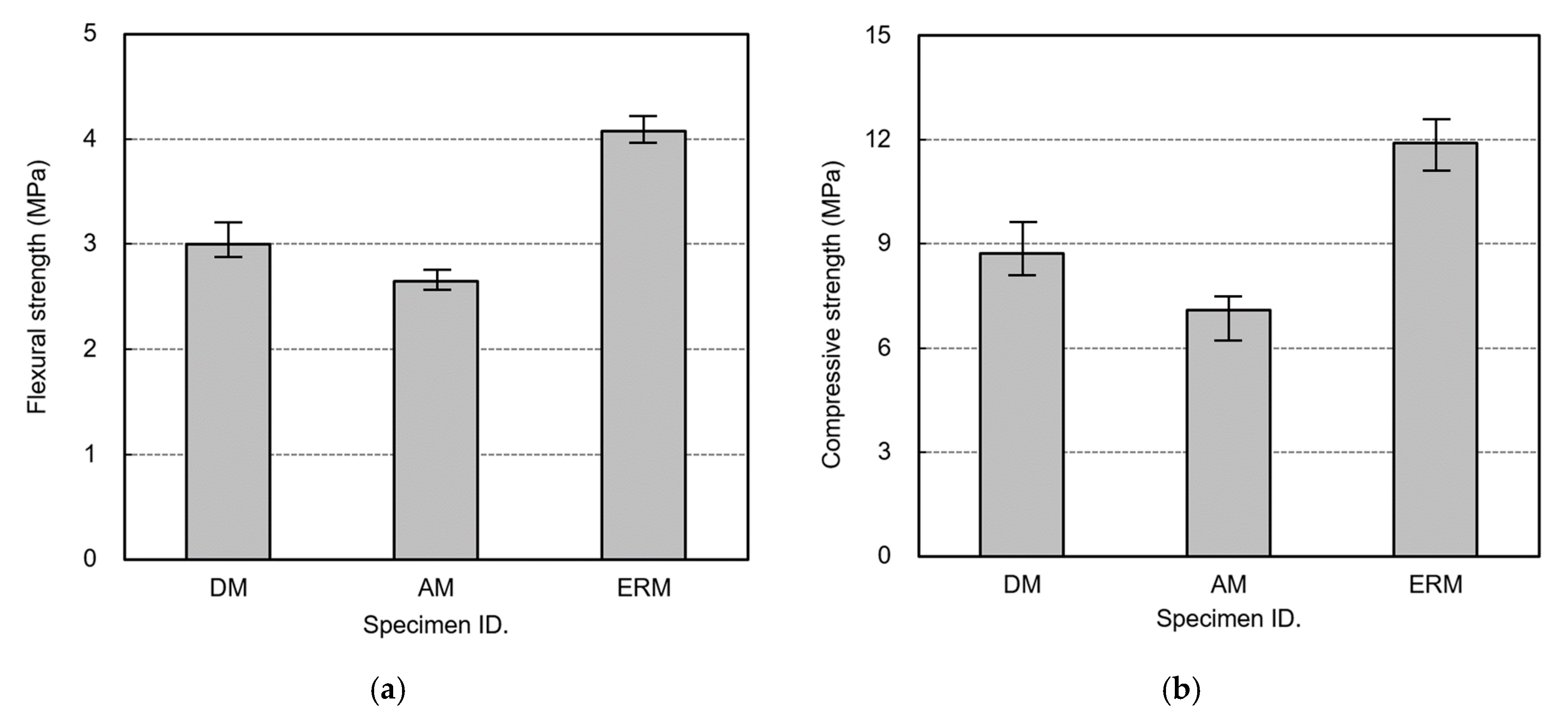
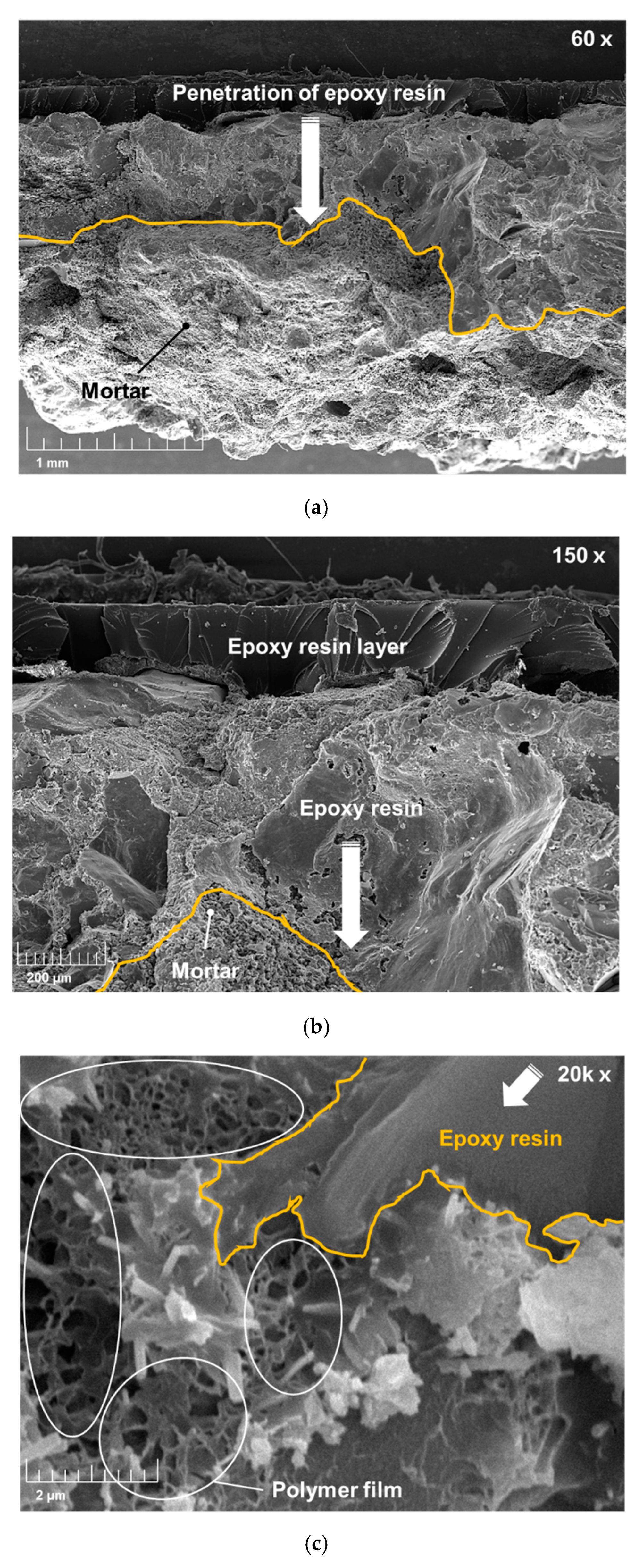
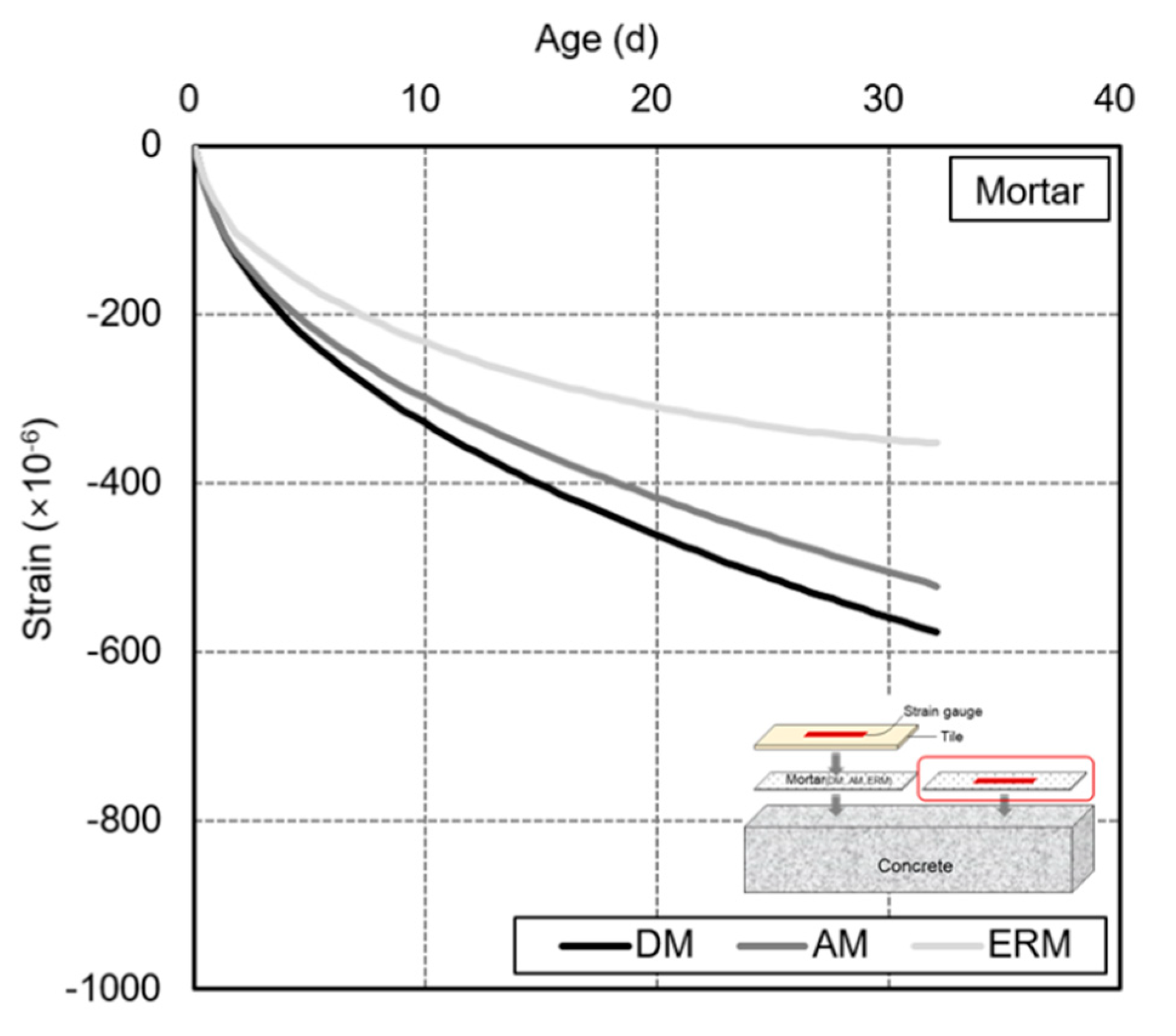
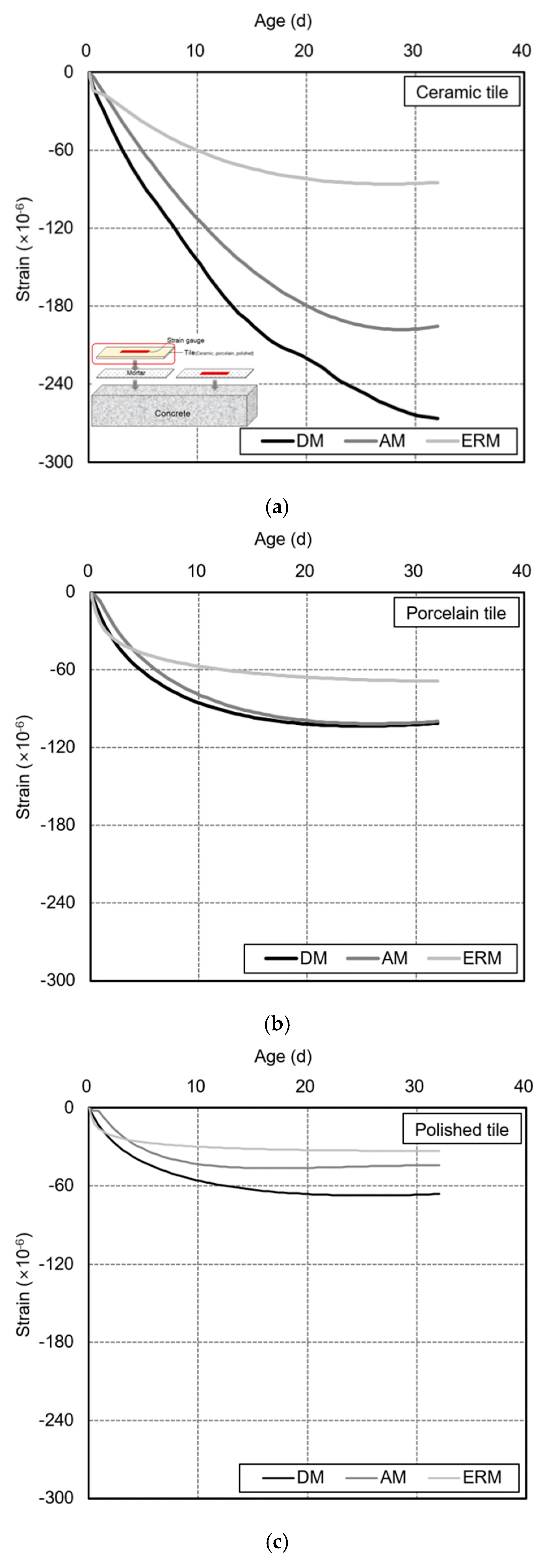
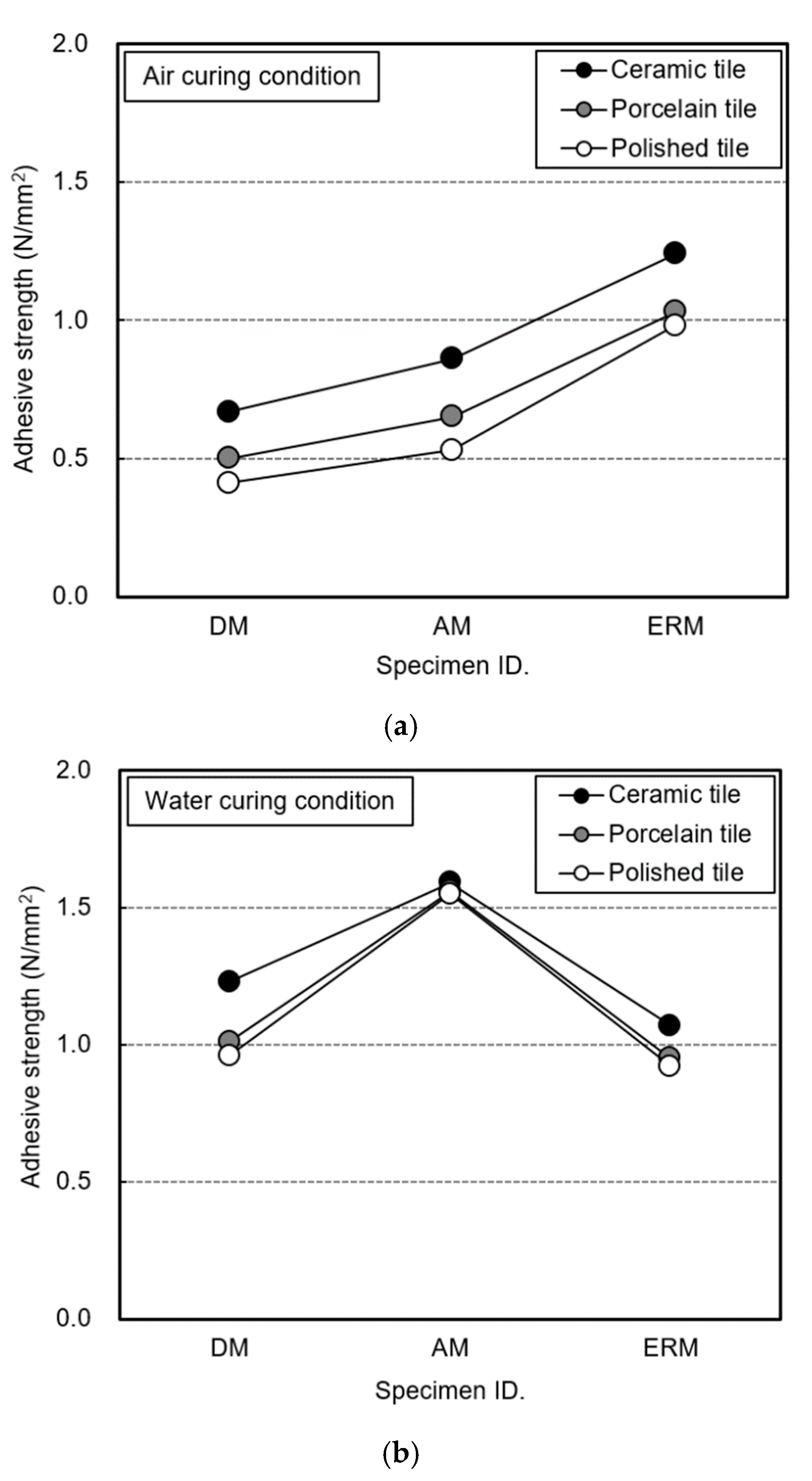
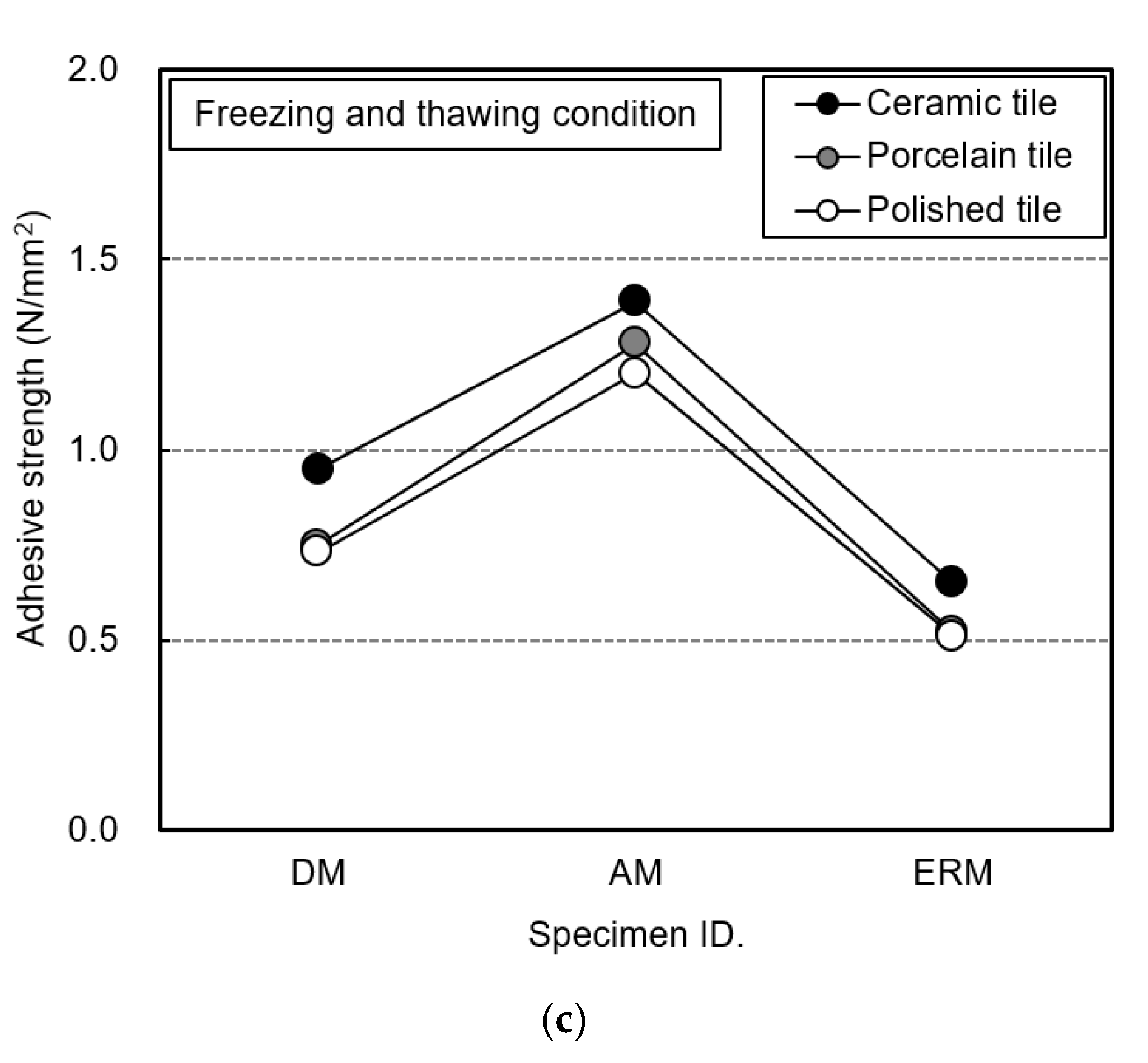


| Materials | DM | AM |
|---|---|---|
| Portland cement | 17 | 20 |
| Quartz sand 0.3–0.9 mm | 20 | |
| Quartz sand 0.1–0.6 mm | 60 | 40 |
| Quartz sand 0.1–0.3 mm | 30 | |
| Dolomite filler | 3 | 6 |
| Redispersible polymer powder | - | 4 |
| Evaluation Item | Adhesive Used 1 | Tile Used |
|---|---|---|
| Viscosity of the epoxy resin adhesive | Epoxy resin adhesive (solvent: 0, 5, 10, 15 wt%) | - |
| Setting time of the epoxy resin adhesive | ||
| Permeability of the epoxy resin adhesive | ||
| Flexural and compressive strength of the mortar | DM AM ERM (solvent: 5 wt%) | |
| Shrinkage of the mortar and tile | Ceramic tile (water absorption ≤ 10%) Porcelain tile (water absorption ≤ 0.5%) Polished tile (water absorption ≤ 0.2%) | |
| Adhesive strength of the tile |
| ID. | Adhesive Strength Based on Curing Conditions, Salt Immersion and Laitance (N/mm2) | ||||||||||||
|---|---|---|---|---|---|---|---|---|---|---|---|---|---|
| Air | Water | Freezing-Thawing | Salt Immersion | Laitance Removal | |||||||||
| Ceramic | Porcelain | Polished | Ceramic | Porcelain | Polished | Ceramic | Porcelain | Polished | Before | After | Before | After | |
| DM | 0.64 0.68 0.70 | 0.49 0.51 0.51 | 0.39 0.41 0.42 | 1.15 1.24 1.29 | 0.93 1.00 1.11 | 0.91 0.98 1.00 | 0.74 0.94 1.16 | 0.66 0.76 0.84 | 0.63 0.72 0.85 | 0.63 0.64 0.67 | 0.28 0.32 0.35 | 0.53 0.56 0.60 | 0.70 0.78 1.88 |
| AM | 0.78 0.82 0.97 | 0.63 0.64 0.67 | 0.51 0.51 0.56 | 1.53 1.60 1.63 | 1.45 1.51 1.71 | 1.51 1.57 1.58 | 1.36 1.37 1.43 | 1.14 1.25 1.46 | 1.08 1.24 1.27 | 0.92 0.93 0.93 | 0.69 0.70 0.73 | 0.69 0.74 0.78 | 0.98 1.02 1.06 |
| ERM | 1.21 1.23 1.27 | 0.99 1.03 1.07 | 0.97 0.97 0.99 | 1.04 1.08 1.10 | 0.93 0.93 0.98 | 0.89 0.91 0.95 | 0.62 0.63 0.69 | 0.46 0.50 0.59 | 0.45 0.51 0.58 | 1.57 1.58 1.61 | 1.24 1.30 1.40 | 1.07 1.09 1.14 | 1.27 1.29 1.34 |
Publisher’s Note: MDPI stays neutral with regard to jurisdictional claims in published maps and institutional affiliations. |
© 2020 by the authors. Licensee MDPI, Basel, Switzerland. This article is an open access article distributed under the terms and conditions of the Creative Commons Attribution (CC BY) license (http://creativecommons.org/licenses/by/4.0/).
Share and Cite
Lee, S.; Lee, S.; Kim, G.; Son, M.; Choe, G.; Lee, J.; Nam, J. Effect of Injecting Epoxy Resin Adhesive into Cement Mortar on Tile Adhesion Performance. Appl. Sci. 2020, 10, 8527. https://doi.org/10.3390/app10238527
Lee S, Lee S, Kim G, Son M, Choe G, Lee J, Nam J. Effect of Injecting Epoxy Resin Adhesive into Cement Mortar on Tile Adhesion Performance. Applied Sciences. 2020; 10(23):8527. https://doi.org/10.3390/app10238527
Chicago/Turabian StyleLee, Sangkyu, Sangyun Lee, Gyuyong Kim, Minjae Son, Gyeongcheol Choe, Jaehyun Lee, and Jeongsoo Nam. 2020. "Effect of Injecting Epoxy Resin Adhesive into Cement Mortar on Tile Adhesion Performance" Applied Sciences 10, no. 23: 8527. https://doi.org/10.3390/app10238527
APA StyleLee, S., Lee, S., Kim, G., Son, M., Choe, G., Lee, J., & Nam, J. (2020). Effect of Injecting Epoxy Resin Adhesive into Cement Mortar on Tile Adhesion Performance. Applied Sciences, 10(23), 8527. https://doi.org/10.3390/app10238527








